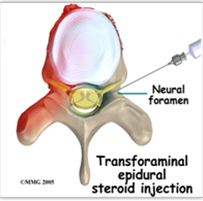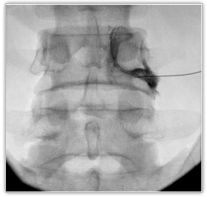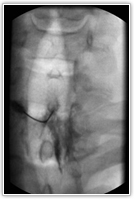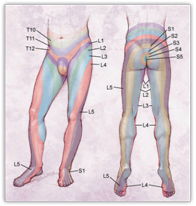Your Treatment Plan at PCI
Epidural glucocorticoid injections are commonly given to patients with leg and/or back pain to relieve such pain and improve mobility without surgery. These steroid injections buy time to allow healing to occur and/or as an attempt to avoid surgery after other conservative (non-surgical) treatment approaches have failed.
During a transforaminal injection, a thin needle is inserted into the epidural space through the bony opening of the exiting nerve root (See Figure 1, Neuroforamen).

Needle entering in the foramen ready to deliver cortisone
The procedure is performed with the patient lying on their belly using fluoroscopic (real-time x-ray) guidance, which helps to prevent damage to the nerve root. A radio-opaque dye is injected to enhance the fluoroscopic images and to confirm that the needle is properly placed (See Figure 2). This technique allows the cortisone medicine to be placed closer to the irritated nerve root. The exposure to radiation is minimal.

Indications include disc herniations, Lumbar canal stenosis, vertebral frctures, tumor compressing epidural space, Herpes zoster pain etc.
Patients with disc herniations and leg pain in most of the studies attained maximal improvement in 6 weeks. Interestingly, long-term success rates for transforaminal epidural glucocorticoid injections ranged from 71% to 84%.
Therapeutic Rationale – why steroids?
- Structures (pain generators) like nerves/discs are accessible to neural blockade.
- Surgery of these structure may fail to cure and may worsen painful spinal conditions.
- Degenerative processes of the spine and the origin of spinal pain is complex.
- The effectiveness of a large variety of therapeutic interventions used to manage chronic spinal pain has not been demonstrated conclusively.
- There is increasing evidence supporting the use of interventional techniques in managing spinal pain
The objective
- To deliver corticosteroid close to the site of pathology
- More effective than a steroid administered either orally or by IV/IM injection
- Caudal and interlaminar – will it reach anteriorly??? Septa, ligaments
- Numerous reports of the effectiveness of epidural corticosteroids have varied in their response rate from 18% to 90%
- However, the cause of this wide disparity - suboptimal placement or non-placement of steroid close to the target site
- TFESI – more specific & targeted
- Decrease size of disc means Decrease symptoms? It is not always the case, as compression may continue in spite of resolution of the symptom
- It is also well described in many studies that asymptomatic individuals present with disc herniations that are evident on CT / MRI scans
A multiple mechanisms to explain radicular pain
Partial axonal damage, Neuroma formation, Focal demyelination, Intraneural edema, Impaired microcirculation, Chemical irritation, Inflammation. The Steroid acts to reverse all these.


Cervical epidural injection, DERMATOME of Lower Limbs
,





